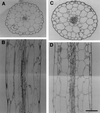Characterization of brassinazole, a triazole-type brassinosteroid biosynthesis inhibitor
- PMID: 10806228
- PMCID: PMC58985
- DOI: 10.1104/pp.123.1.93
Characterization of brassinazole, a triazole-type brassinosteroid biosynthesis inhibitor
Abstract
Screening for brassinosteroid (BR) biosynthesis inhibitors was performed to find chemicals that induce dwarfism in Arabidopsis, mutants that resembled BR biosynthesis mutants that can be rescued by BR. Through this screening experiment, the compound brassinazole was selected as the most potent chemical. In dark-grown Arabidopsis, brassinazole-induced morphological changes were nearly restored to those of wild type by treatment with brassinolide. The structure of brassinazole is similar to pacrobutrazol, a gibberellin biosynthesis inhibitor. However, in assays with cress (Lepidium sativum) plants, brassinazole-treated plants did not show recovery after the addition of gibberellin but showed good recovery after the addition of brassinolide. These data demonstrate that brassinazole is a specific BR biosynthesis inhibitor. Brassinazole-treated cress also showed dwarfism, with altered leaf morphology, including the downward curling and dark green color typical of Arabidopsis BR-deficient mutants, and this dwarfism was reversed by the application of 10 nM brassinolide. This result suggests that BRs are essential for plant growth, and that brassinazole can be used to clarify the function of BRs in plants as a complement to BR-deficient mutants. The brassinazole action site was also investigated by feeding BR biosynthesis intermediates to cress grown in the light.
Figures








References
-
- Asami T, Yoshida S. Brassinosteroid biosynthesis inhibitors. Trends Plant Sci. 1999;4:348–353. - PubMed
-
- Buschmann E, Zeeh B, Gotz N, Sproesser L, Walker N (1987) Chelat kontrollierte Grignard-Reaktionen mit α-(1H-1,2,4-Triazol-1-yl) ketonen. Liebigs Ann Chem 349–355
Publication types
MeSH terms
Substances
LinkOut - more resources
Full Text Sources
Other Literature Sources

